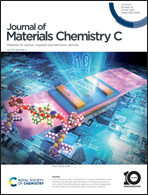Asymmetric diarylamine guests for a host–guest system with stimulus-responsive room temperature phosphorescence†
Abstract
The Förster resonance energy transfer (FRET) process has been utilized to construct host–guest systems with stimuli-responsive room-temperature phosphorescence (RTP). However, only two guests have been reported for these systems. Thus, the design of new guests and investigation of their molecular structural effects on their RTP properties has become an important and challenging work for improving their stimuli-responsive performance. In this work, a series of asymmetric diarylamine guests were designed and prepared for the DMAP host to construct host–guest systems, which exhibited stimuli-responsive RTP to heating, pressing, grinding and pH values; and it was revealed that the FRET process changes were the key to the stimulus-responsive RTP, by careful investigation. Interestingly, the host–guest system of DMAP/MDPA-Ph showed the best RTP performance, in which the T1h state of the host is close to the center between S1g and T1g states of the guest. Based on the time-resolved characteristics of RTP of these systems, anti-counterfeiting applications could be achieved through screen-printing or stamping processes. This work thus opened up a way to achieve excellent performance of stimulus-responsive RTP materials through molecular design of the guest.

- This article is part of the themed collection: Photofunctional Materials and Transformations


 Please wait while we load your content...
Please wait while we load your content...